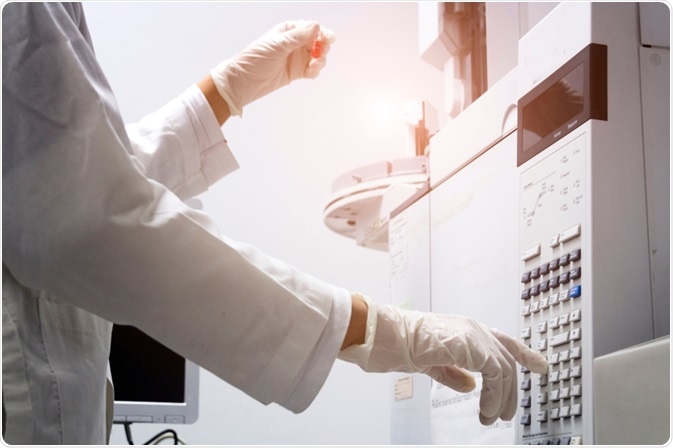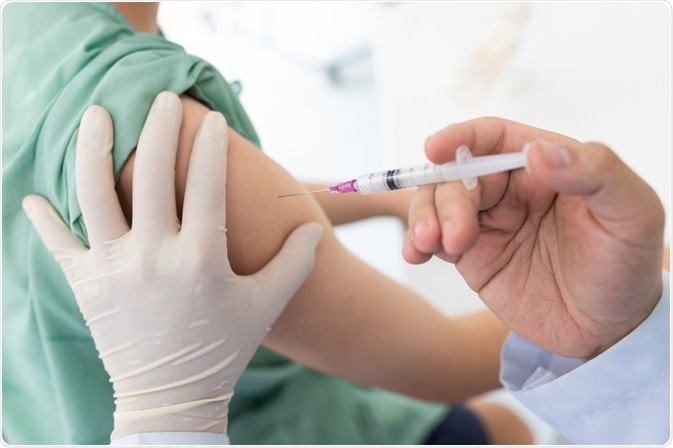Chromatography is used to separate mixtures of compounds and is essential to many sectors of the life science industry. Many specialized types of chromatography have been developed for a specific purpose, though all consist of a fluid mobile phase (liquid or gas) that carries the compounds of interest through the stationary phase material, which modulates the rate at which the compounds flow and separates them by differential affinity.

Chromatography. Image Credit: Ropisme/Shutterstock.com
The type of chromatography employed, and the detailed composition of the mobile and stationary phases, are highly dependent on the molecules being separated. Many chromatographic systems separate molecules based on polarity, while others distinguish by size, ionic charge, or boiling point. Further refinement of mobile phase flow rate and other factors can improve separation between similar molecules.
Any field of life science that requires separation and purification of samples for characterization or testing purposes may employ some type of chromatography, with the specific type determined by the chemical characteristics of the compounds in question. Some of the major applications are discussed below.
Chromatography and drug testing
Bodily fluids including blood and urine can undergo chromatography to separate the naturally occurring compounds therein from any metabolic byproducts produced by the consumption of drugs. Most compounds have a relatively short half-life in the blood, and the method of collection is invasive while requiring trained personnel to collect, so urine testing is generally preferred.
Many compounds can be detected in urine several months following consumption, such as cannabinoids, while opiate and cocaine metabolic products tend to linger just days. Chromatography techniques are often combined with subsequent mass spectrometry to characterize the separated compounds.
Quantitative analysis of drugs in urine is usually performed either by gas chromatography-mass spectrometry or liquid chromatography-mass spectrometry, the former being more time and sample consuming but better encompassing in the detection of a wider range of molecules. Evidence of the consumption of drugs and poisons can similarly be collected from the deceased using chromatography in forensic applications.
Chromatography and drug manufacture
High-performance liquid chromatography is considered the gold standard for compound separation before characterization in the pharmaceutical industry. The technique is generally used at the quality control stage, quantitatively defining the composition of a product. As in other applications, further characterization can then be undertaken of the separated compounds.
Chromatography may also be used to purify intermediate products throughout the stages of synthesis, and sophisticated modern automated processes allow crude products to be refined continuously on an optimum timescale.
Chromatography and vaccines
As in the synthesis of other pharmaceutical products, many vaccines undergo purification by chromatography during or in the final stages of production. The antigen of interest to the production of the vaccine also may be obtained by chromatography, for example, the SARS coronavirus spike protein has been isolated by liquid chromatography allowing it to be produced in good quantities. This has enabled researchers to perform a variety of tests on the isolated protein, revealing many structural and biochemical characteristics that explain the high infectivity of the virus, and has allowed the development of vaccines against it.
Vaccines may contain the inactivated or attenuated free virus, or just the antigen that the body’s immune defenses recognize. In any case, chromatography is often used to separate the components of interest from by-products and compounds present in the growth medium of the cells within which the virus or proteins are cultured.

Vaccine. Image Credit: Tong_stocker/Shutterstock.com
Chromatography and food
Food products contain a large and complex mixture of compounds, which may be naturally occurring or imparted at a later stage of the manufacturing or harvesting process. Many such compounds may be a cause for concern when present in food products above a particular concentration, and several types of chromatography are generally used to separate the numerous compounds from one another for deeper analysis.
For example, plant-based products may bear lingering traces of pesticides, while meat may contain veterinary drugs. In addition to detecting potentially toxic impurities in food products, chromatography is used to standardize and authenticate the nutritional profile of many goods at the quality control stage.
Chromatography and the environment
Aspects of environmental quality can also be assessed and monitored using chromatography. The concentration of pollutants in water, soil, and air are each regularly determined firstly by mixture separation by chromatography in tandem with other characterization techniques such as mass spectrometry. This process has proven vital in city planning and assessing the impact of industry on particular locations and the planet in general.
Sources:
- Dams, R., Murphy, C. M., Lambert, W. E. & Huestis, M. A. (2003) Urine drug testing for opioids, cocaine, and metabolites by direct injection liquid chromatography/tandem mass spectrometry. Rapid communications in mass spectrometry, 17(14).
analyticalsciencejournals.onlinelibrary.wiley.com/.../rcm.1098
- Zuo, X. et al. (2005) Expression and purification of SARS coronavirus proteins using SUMO-fusions. Protein expression and purification, 42(1).
https://www.ncbi.nlm.nih.gov/pmc/articles/PMC7129641/
- Vaccine Manufacturing (2018) Plotkins Vaccines. Stanley A. Plotkin. Elsevier.
https://www.ncbi.nlm.nih.gov/pmc/articles/PMC7152262/
- Nunez, O. & Lucci, P. (2020) Application of Liquid Chromatography in Food Analysis. Foods, 9(1277).
https://www.mdpi.com/2304-8158/9/9/1277/pdf
- Poole, S. K. & Poole, C. F. (1999) Chromatographic models for the sorption of neutral organic compounds by soil from water and air. Journal of chromatography A, 845(1).
www.sciencedirect.com/.../S0021967398010851
Further Reading